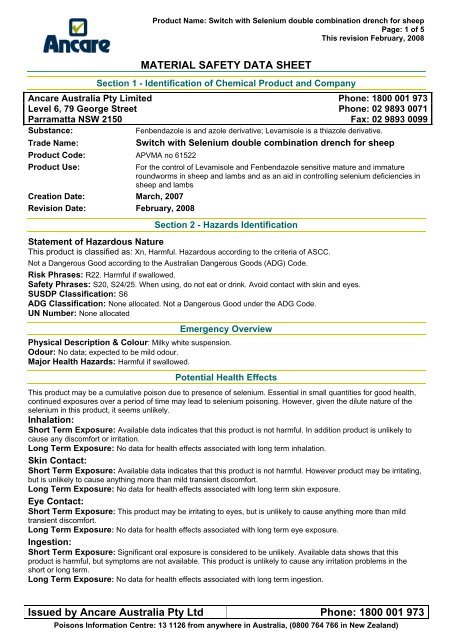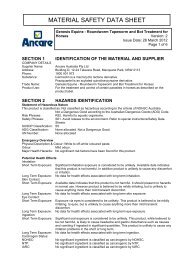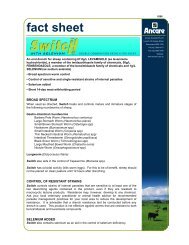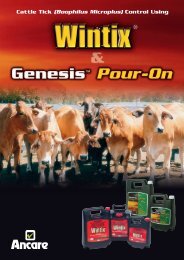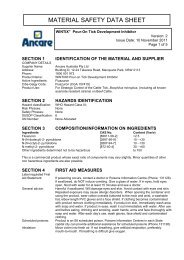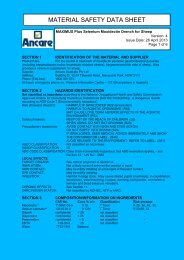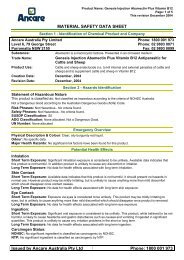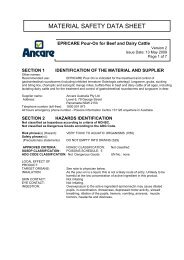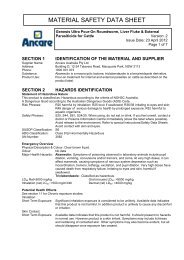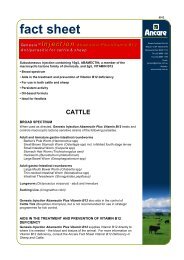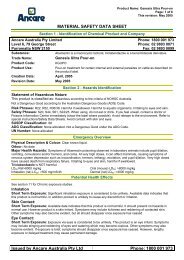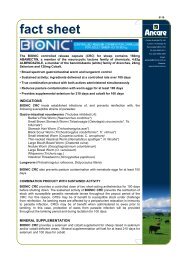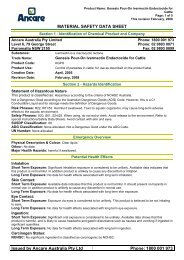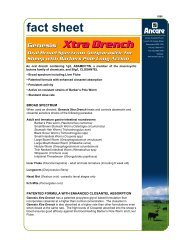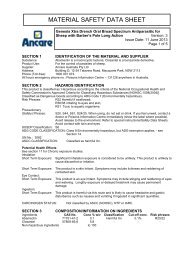Switch with Selenium double combination drench for sheep - Ancare
Switch with Selenium double combination drench for sheep - Ancare
Switch with Selenium double combination drench for sheep - Ancare
Create successful ePaper yourself
Turn your PDF publications into a flip-book with our unique Google optimized e-Paper software.
Product Name: <strong>Switch</strong> <strong>with</strong> <strong>Selenium</strong> <strong>double</strong> <strong>combination</strong> <strong>drench</strong> <strong>for</strong> <strong>sheep</strong><br />
Page: 1 of 5<br />
This revision February, 2008<br />
MATERIAL SAFETY DATA SHEET<br />
Section 1 - Identification of Chemical Product and Company<br />
<strong>Ancare</strong> Australia Pty Limited Phone: 1800 001 973<br />
Level 6, 79 George Street Phone: 02 9893 0071<br />
Parramatta NSW 2150 Fax: 02 9893 0099<br />
Substance:<br />
Fenbendazole is and azole derivative; Levamisole is a thiazole derivative.<br />
Trade Name:<br />
<strong>Switch</strong> <strong>with</strong> <strong>Selenium</strong> <strong>double</strong> <strong>combination</strong> <strong>drench</strong> <strong>for</strong> <strong>sheep</strong><br />
Product Code: APVMA no 61522<br />
Product Use:<br />
For the control of Levamisole and Fenbendazole sensitive mature and immature<br />
roundworms in <strong>sheep</strong> and lambs and as an aid in controlling selenium deficiencies in<br />
<strong>sheep</strong> and lambs<br />
Creation Date: March, 2007<br />
Revision Date: February, 2008<br />
Section 2 - Hazards Identification<br />
Statement of Hazardous Nature<br />
This product is classified as: Xn, Harmful. Hazardous according to the criteria of ASCC.<br />
Not a Dangerous Good according to the Australian Dangerous Goods (ADG) Code.<br />
Risk Phrases: R22. Harmful if swallowed.<br />
Safety Phrases: S20, S24/25. When using, do not eat or drink. Avoid contact <strong>with</strong> skin and eyes.<br />
SUSDP Classification: S6<br />
ADG Classification: None allocated. Not a Dangerous Good under the ADG Code.<br />
UN Number: None allocated<br />
Emergency Overview<br />
Physical Description & Colour: Milky white suspension.<br />
Odour: No data; expected to be mild odour.<br />
Major Health Hazards: Harmful if swallowed.<br />
Potential Health Effects<br />
This product may be a cumulative poison due to presence of selenium. Essential in small quantities <strong>for</strong> good health,<br />
continued exposures over a period of time may lead to selenium poisoning. However, given the dilute nature of the<br />
selenium in this product, it seems unlikely.<br />
Inhalation:<br />
Short Term Exposure: Available data indicates that this product is not harmful. In addition product is unlikely to<br />
cause any discom<strong>for</strong>t or irritation.<br />
Long Term Exposure: No data <strong>for</strong> health effects associated <strong>with</strong> long term inhalation.<br />
Skin Contact:<br />
Short Term Exposure: Available data indicates that this product is not harmful. However product may be irritating,<br />
but is unlikely to cause anything more than mild transient discom<strong>for</strong>t.<br />
Long Term Exposure: No data <strong>for</strong> health effects associated <strong>with</strong> long term skin exposure.<br />
Eye Contact:<br />
Short Term Exposure: This product may be irritating to eyes, but is unlikely to cause anything more than mild<br />
transient discom<strong>for</strong>t.<br />
Long Term Exposure: No data <strong>for</strong> health effects associated <strong>with</strong> long term eye exposure.<br />
Ingestion:<br />
Short Term Exposure: Significant oral exposure is considered to be unlikely. Available data shows that this<br />
product is harmful, but symptoms are not available. This product is unlikely to cause any irritation problems in the<br />
short or long term.<br />
Long Term Exposure: No data <strong>for</strong> health effects associated <strong>with</strong> long term ingestion.<br />
Issued by <strong>Ancare</strong> Australia Pty Ltd Phone: 1800 001 973<br />
Poisons In<strong>for</strong>mation Centre: 13 1126 from anywhere in Australia, (0800 764 766 in New Zealand)
Product Name: <strong>Switch</strong> <strong>with</strong> <strong>Selenium</strong> <strong>double</strong> <strong>combination</strong> <strong>drench</strong> <strong>for</strong> <strong>sheep</strong><br />
Page: 2 of 5<br />
This revision February, 2008<br />
MATERIAL SAFETY DATA SHEET<br />
Carcinogen Status:<br />
ASCC: No significant ingredient is classified as carcinogenic by ASCC.<br />
NTP: No significant ingredient is classified as carcinogenic by NTP.<br />
IARC: No significant ingredient is classified as carcinogenic by IARC.<br />
Section 3 - Composition/In<strong>for</strong>mation on Ingredients<br />
Ingredients CAS No Conc,%w/w TWA (mg/m 3 ) STEL (mg/m 3 )<br />
Levamisole hydrochloride 5036-02-2 67.8g/L* not set not set<br />
Fenbendazole 43210-67-9 50g/L not set not set<br />
Sodium selenate 13410-01-0 1g/L** not set not set<br />
Other non hazardous ingredients secret
Product Name: <strong>Switch</strong> <strong>with</strong> <strong>Selenium</strong> <strong>double</strong> <strong>combination</strong> <strong>drench</strong> <strong>for</strong> <strong>sheep</strong><br />
Page: 3 of 5<br />
This revision February, 2008<br />
MATERIAL SAFETY DATA SHEET<br />
or mists are likely to build up in the cleanup area, we recommend that you use a respirator. Usually, no respirator is<br />
necessary when using this product. However, if you have any doubts consult the Australian Standard mentioned<br />
below (section 8).<br />
Stop leak if safe to do so, and contain spill. Absorb onto sand, vermiculite or other suitable absorbent material. If spill<br />
is too large or if absorbent material is not available, try to create a dike to stop material spreading or going into drains<br />
or waterways. Sweep up and shovel or collect recoverable product into labelled containers <strong>for</strong> recycling or salvage,<br />
and dispose of promptly. Recycle containers wherever possible after careful cleaning. Refer to product label <strong>for</strong><br />
specific instructions. After spills, wash area preventing runoff from entering drains. If a significant quantity of material<br />
enters drains, advise emergency services. Full details regarding disposal of used containers, spillage and unused<br />
material may be found on the label. If there is any conflict between this MSDS and the label, instructions on the label<br />
prevail. Ensure legality of disposal by consulting regulations prior to disposal. Thoroughly launder protective clothing<br />
be<strong>for</strong>e storage or re-use. Advise laundry of nature of contamination when sending contaminated clothing to laundry.<br />
Section 7 - Handling and Storage<br />
Handling: Keep exposure to this product to a minimum, and minimise the quantities kept in work areas. Check<br />
Section 8 of this MSDS <strong>for</strong> details of personal protective measures, and make sure that those measures are followed.<br />
The measures detailed below under "Storage" should be followed during handling in order to minimise risks to<br />
persons using the product in the workplace. Also, avoid contact or contamination of product <strong>with</strong> incompatible<br />
materials listed in Section 10.<br />
Storage: This product is a Scheduled Poison. Observe all relevant regulations regarding sale, transport and storage<br />
of this schedule of poison. Store in the closed original container in a dry, cool, well-ventilated area out of direct<br />
sunlight. Make sure that the product does not come into contact <strong>with</strong> substances listed under "Incompatibilities" in<br />
Section 10. Some liquid preparations settle or separate on standing and may require stirring be<strong>for</strong>e use. Check<br />
packaging - there may be further storage instructions on the label.<br />
Section 8 - Exposure Controls and Personal Protection<br />
The following Australian Standards will provide general advice regarding safety clothing and equipment:<br />
Respiratory equipment: AS/NZS 1715, Protective Gloves: AS 2161, Industrial Clothing: AS2919, Industrial Eye<br />
Protection: AS1336 and AS/NZS 1337, Occupational Protective Footwear: AS/NZS2210.<br />
ASCC Exposure limits TWA (mg/m 3 ) STEL (mg/m 3 )<br />
Exposure limits have not been established by ASCC <strong>for</strong> any of the significant ingredients in this product.<br />
The ADI <strong>for</strong> Fenbendazole is set at 0.05mg/kg/day. The corresponding NOEL is set at 5mg/kg/day.<br />
The ADI <strong>for</strong> Levamisole is set at 0.003mg/kg/day. The corresponding NOEL is set at 6mg/kg/day.<br />
ADI means Acceptable Daily Intake and NOEL means No-observable-effect-level. Values taken from Australian ADI<br />
List, Dec 2006.<br />
No special equipment is usually needed when occasionally handling small quantities. The following instructions are<br />
<strong>for</strong> bulk handling or where regular exposure in an occupational setting occurs <strong>with</strong>out proper containment systems.<br />
Ventilation: No special ventilation requirements are normally necessary <strong>for</strong> this product. However make sure that<br />
the work environment remains clean and that vapours and mists are minimised.<br />
Eye Protection: Eye protection such as protective glasses or goggles is recommended when this product is being<br />
used.<br />
Skin Protection: You should avoid contact even <strong>with</strong> mild skin irritants. There<strong>for</strong>e you should wear suitable<br />
impervious elbow-length gloves and facial protection when handling this product. See below <strong>for</strong> suitable material<br />
types.<br />
Protective Material Types: We suggest that protective clothing be made from the following materials: rubber,<br />
PVC.<br />
Respirator: Usually, no respirator is necessary when using this product. However, if you have any doubts consult<br />
the Australian Standard mentioned above.<br />
Section 9 - Physical and Chemical Properties:<br />
Physical Description & colour: Milky white suspension.<br />
Odour:<br />
No data; expected to be mild odour.<br />
Boiling Point:<br />
Approximately 100°C at 100kPa.<br />
Freezing/Melting Point: Approximately 0°C.<br />
Volatiles:<br />
Water component.<br />
Issued by <strong>Ancare</strong> Australia Pty Ltd Phone: 1800 001 973<br />
Poisons In<strong>for</strong>mation Centre: 13 1126 from anywhere in Australia, (0800 764 766 in New Zealand)
Product Name: <strong>Switch</strong> <strong>with</strong> <strong>Selenium</strong> <strong>double</strong> <strong>combination</strong> <strong>drench</strong> <strong>for</strong> <strong>sheep</strong><br />
Page: 4 of 5<br />
This revision February, 2008<br />
MATERIAL SAFETY DATA SHEET<br />
Vapour Pressure:<br />
2.37 kPa at 20°C (water vapour pressure).<br />
Vapour Density:<br />
No data.<br />
Specific Gravity: Approx 1.0<br />
Water Solubility:<br />
Completely soluble in water.<br />
pH:<br />
No data.<br />
Volatility:<br />
No data.<br />
Odour Threshold:<br />
No data.<br />
Evaporation Rate:<br />
No data.<br />
Coeff Oil/water Distribution: No data<br />
Autoignition temp:<br />
Not applicable - does not burn.<br />
Section 10 - Stability and Reactivity<br />
Reactivity: This product is unlikely to react or decompose under normal storage conditions. However, if you have<br />
any doubts, contact the supplier <strong>for</strong> advice on shelf life properties.<br />
Conditions to Avoid: Store in the closed original container in a dry, cool, well-ventilated area out of direct sunlight.<br />
Incompatibilities: No particular Incompatibilities.<br />
Fire Decomposition: Only small quantities of decomposition products are expected from this products at<br />
temperatures normally achieved in a fire. This will only occur after heating to dryness. Carbon dioxide, and if<br />
combustion is incomplete, carbon monoxide and smoke. Nitrogen and its compounds, and under some<br />
circumstances, oxides of nitrogen. Occasionally hydrogen cyanide gas in reducing atmospheres. Oxides of sulfur<br />
(sulfur dioxide is a respiratory hazard) and other sulfur compounds. Most will have a foul odour. Hydrogen chloride<br />
gas, other compounds of chlorine. Water, sodium compounds. Carbon monoxide poisoning produces headache,<br />
weakness, nausea, dizziness, confusion, dimness of vision, disturbance of judgment, and unconsciousness followed<br />
by coma and death.<br />
Polymerisation: This product will not undergo polymerisation reactions.<br />
Section 11 - Toxicological In<strong>for</strong>mation<br />
Local Effects:<br />
Target Organs:<br />
There is no data to hand indicating any particular target organs.<br />
Toxicity: Toxic dose <strong>for</strong> Fenbendazole was not found. 500mg/kg was not toxic in a single dose. 250mg/kg daily <strong>for</strong><br />
30 days was not toxic to dogs.<br />
A detailed report on Fenbendazole may be found at http://www.inchem.org/documents/jecfa/jecmono/v29je04.htm<br />
The most significant toxicological findings <strong>with</strong> Fenbendazole were in the rat liver. However, Fenbendazole appears to<br />
be nongenotoxic.<br />
The following data were found <strong>for</strong> Levamisole:<br />
LD 50 (Oral), mouse 210mg/kg<br />
LD 50 (Oral), rat 480mg/kg<br />
LD 50 (IV), mouse 22mg/kg<br />
LD 50 (IV), rat 24mg/kg<br />
LD 50 (SC), mouse 84mg/kg<br />
LD 50 (SC), rat 130mg/kg<br />
A potential mutagen, levamisole induced chromosome gaps and breaks in human lymphocytes in vitro and in vivo and<br />
induced an increase in the mitotic index, numerical chromosomal changes (aneuploidy, polyploidy) and structural<br />
chromosomal changes]. Haemolytic anaemic was the main toxic effect demonstrated in repeated dose animal studies<br />
(LOAEL 1.25mg/kg/day). In humans, levamisole has been associated <strong>with</strong> various nonspecific effects (nausea,<br />
vomiting, rashes). Levamisole has induced leucopenia and agranulocytosis (idiosyncratic) at low doses.<br />
No cumulative effects are to be found <strong>with</strong> Levamisole or Fenbendazole. However, <strong>Selenium</strong> may accumulate<br />
in the body and so persistent mild exposures may lead to health problems.<br />
Classification of Hazardous Ingredients<br />
Ingredient<br />
Risk Phrases<br />
No ingredient mentioned in the HSIS Database is present in this product at hazardous concentrations.<br />
Section 12 - Ecological In<strong>for</strong>mation<br />
Insufficient data to be sure of status.<br />
Levamisole and Fenbendazole are not toxic to birds, fish and honey bees. They do not bioaccumulate in animal<br />
systems. In soil, each has a half life of 5 to 70 days depending on sunlight, soil type and climatic conditions. Each also<br />
does not leach into soils and is readily degraded by hydrolysis and microbial action.<br />
Issued by <strong>Ancare</strong> Australia Pty Ltd Phone: 1800 001 973<br />
Poisons In<strong>for</strong>mation Centre: 13 1126 from anywhere in Australia, (0800 764 766 in New Zealand)
Product Name: <strong>Switch</strong> <strong>with</strong> <strong>Selenium</strong> <strong>double</strong> <strong>combination</strong> <strong>drench</strong> <strong>for</strong> <strong>sheep</strong><br />
Page: 5 of 5<br />
This revision February, 2008<br />
MATERIAL SAFETY DATA SHEET<br />
Section 13 - Disposal Considerations<br />
Disposal: There are many pieces of legislation covering waste disposal and they differ in each state and territory, so<br />
each user must refer to laws operating in their area. In some areas, certain wastes must be tracked. The Hierarchy of<br />
Controls seems to be common - the user should investigate: Reduce, Reuse, and Recycle and only if all else fails<br />
should disposal be considered. Note that properties of a product may change in use, so that the following suggestions<br />
may not always be appropriate. The following may help you in properly addressing this matter <strong>for</strong> this product. Special<br />
help is available <strong>for</strong> the disposal of Agricultural Chemicals. The product label will give general advice regarding<br />
disposal of small quantities, and how to cleanse containers. However, <strong>for</strong> help <strong>with</strong> the collection of unwanted rural<br />
chemicals, contact ChemClear 1800 008 182 http://www.chemclear.com.au/ and <strong>for</strong> help <strong>with</strong> the disposal of empty<br />
drums, contact DrumMuster http://www.drummuster.com.au/ where you will find contact details <strong>for</strong> your area.<br />
Section 14 - Transport In<strong>for</strong>mation<br />
ADG Code: This product is not classified as a Dangerous Good. No special transport conditions are necessary<br />
unless required by other regulations.<br />
Section 15 - Regulatory In<strong>for</strong>mation<br />
AICS: All of the significant ingredients in this <strong>for</strong>mulation are compliant <strong>with</strong> NICNAS regulations.<br />
The following ingredients: Levamisole, Fenbendazole, selenium compounds, are mentioned in the SUSDP.<br />
Section 16 - Other In<strong>for</strong>mation<br />
Acronyms:<br />
ADG Code<br />
AICS<br />
ASCC<br />
CAS Number<br />
Hazchem Number<br />
IARC<br />
NOS<br />
NTP<br />
R-Phrase<br />
SUSDP<br />
UN Number<br />
This MSDS contains only safety-related in<strong>for</strong>mation. For other data see product literature.<br />
Australian Code <strong>for</strong> the Transport of Dangerous Goods by Road and Rail<br />
Australian Inventory of Chemical Substances<br />
Office of the Australian Safety and Compensation Council<br />
Chemical Abstracts Service Registry Number<br />
Emergency action code of numbers and letters that provide in<strong>for</strong>mation to<br />
emergency services especially firefighters<br />
International Agency <strong>for</strong> Research on Cancer<br />
Not otherwise specified<br />
National Toxicology Program (USA)<br />
Risk Phrase<br />
Standard <strong>for</strong> the Uni<strong>for</strong>m Scheduling of Drugs & Poisons<br />
United Nations Number<br />
THIS MSDS SUMMARISES OUR BEST KNOWLEDGE OF THE HEALTH AND SAFETY HAZARD INFORMATION OF THE PRODUCT AND<br />
HOW TO SAFELY HANDLE AND USE THE PRODUCT IN THE WORKPLACE. EACH USER MUST REVIEW THIS MSDS IN THE CONTEXT OF<br />
HOW THE PRODUCT WILL BE HANDLED AND USED IN THE WORKPLACE.<br />
IF CLARIFICATION OR FURTHER INFORMATION IS NEEDED TO ENSURE THAT AN APPROPRIATE RISK ASSESSMENT CAN BE MADE,<br />
THE USER SHOULD CONTACT THIS COMPANY SO WE CAN ATTEMPT TO OBTAIN ADDITIONAL INFORMATION FROM OUR SUPPLIERS<br />
Please read all labels carefully be<strong>for</strong>e using product.<br />
This MSDS is prepared in accord <strong>with</strong> the ASCC document “National Code of Practice <strong>for</strong> the Preparation<br />
of Material Safety Data Sheets” 2nd Edition [NOHSC:2011(2003)]<br />
Copyright © Kil<strong>for</strong>d & Kil<strong>for</strong>d Pty Ltd, February, 2008.<br />
http://www.kil<strong>for</strong>d.com.au/ Phone (02)9251 4532<br />
Issued by <strong>Ancare</strong> Australia Pty Ltd Phone: 1800 001 973<br />
Poisons In<strong>for</strong>mation Centre: 13 1126 from anywhere in Australia, (0800 764 766 in New Zealand)


